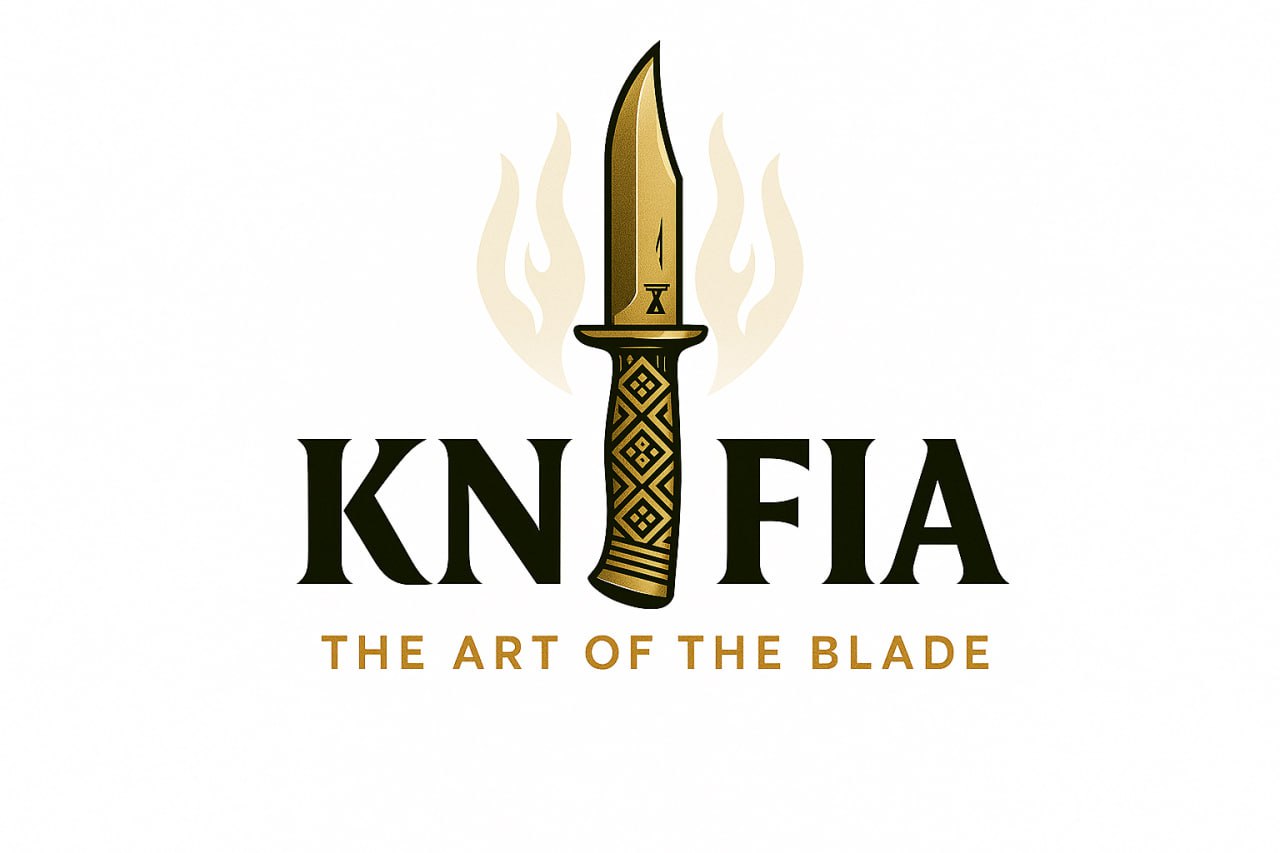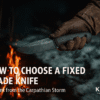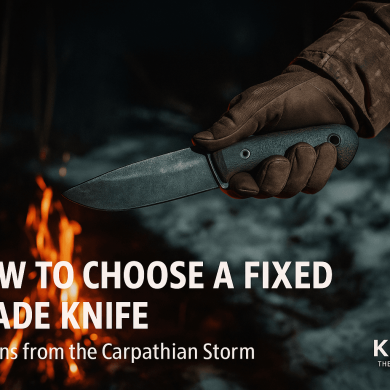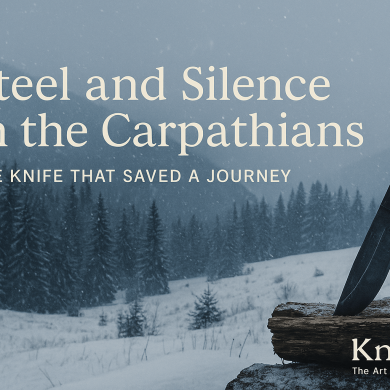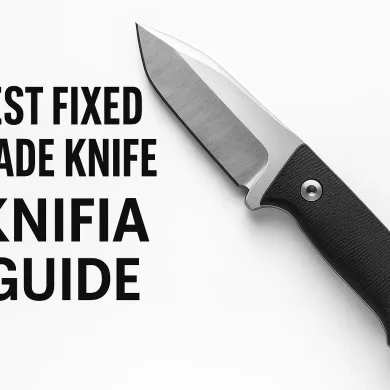No products in the cart.
By Knifia – The Art of the Blade
I remember the smell first. Not the steel—though steel has its own clean, mineral breath—but the little workshop the old man kept at the back of the house, where dust floated like winter sun and everything had a place because everything had a purpose. It was there that I first learned the meaning of craftsmanship through a handmade fixed blade knife — the kind that outlasts its owner and tells a story long after words fade. There was the orange of boiled linseed oil, the black of stove ash, the faint sweetness of worn leather, and somewhere underneath it all, a promise. He called it a bench; to me, it was a small cathedral.
My father didn’t believe in perfect things. He believed in honest ones. “Pretty breaks fast,” he’d say, tapping a cheap plastic handle with his knuckle, the way a carpenter tests a wall for hollowness. “Honest lasts.” When I was twelve, he pressed a parcel into my hands, wrapped in old cloth and tied with twine. The weight of it was small but not light. “A tool,” he said. “Not a toy. It remembers how you use it.”
Inside was my first handmade fixed blade knife – not shiny, not dramatic, but shaped like an answer. The scales were Micarta, olive, and dark, where the palm would rest, warm even in that cold shed. The blade was four and a half inches with a flat grind that looked like it would rather do work than start an argument. I didn’t understand any of that then. I only knew that when I held it, my heartbeat changed, as if the tool had a pulse and it had agreed to match mine.
“Hold it,” he said. “Don’t show it off. Tools listen to pride, and they punish it. Let your hand settle first.”
I held it. The balance found me before I tried to find it. The blade didn’t tip forward like a boast or pull back like a flinch. It just lived there, between bone and tendon, as if the hand had been designed around it instead of the other way round. He watched my grip and made small adjustments. The corrections were not scolding; they were kind.
He showed me how to make curls from a dry stick that lifted like feathers, thin enough to be persuaded by a single spark. He showed me how to notch a branch without digging a grave for the edge. He showed me how to push with the heel and how to draw with the belly. “The knife is not your strength,” he said. “It’s your accuracy.”
Later, when the house had fallen asleep and the kitchen clock spoke in seconds, he opened the drawer where he kept the stones. Not fancy ceramics or diamond plates back then – just oiled stones that had outlived several lives. “One day you’ll buy other things,” he said, and he smiled at the future in a way that made me love him. “But this is enough. The knife wants angles more than it wants gadgets.”
We sharpened under the yellow lamp, small, careful circles, then longer strokes that felt like writing a letter we were both afraid to send. When he lifted the edge to the light and shaved a hair from his wrist, he didn’t grin like a showman. He nodded like a farmer after good rain. “Now it will listen to you,” he said. “Now it is ready to be taught.”
A Lesson in Steel
Years later, I learned the words for what his hands already knew. That a handmade fixed blade knife begins with a decision about steel that is not just chemistry; it is character. He never said “HRC” or “powder metallurgy.” He’d talk about what a blade could endure and what it needed in return. But because he loved truth, he would have loved the facts: that harder steels (59–61 HRC) hold an edge like a promise but need respect when struck; that tougher steels at 57–58 HRC forgive mistakes and repay you in winter, in wet, in shock.
I learned the names of the way children learn the names of constellations – because they point you home. Tool steels like K110 and D2 with their stubborn wear resistance; stainless like N690 when rivers and kitchens ask for mercy from rust; the powder steels—Elmax, CPM-3V—where grain size goes fine as snow and bite meets brawn. I learned that 1095 is a friend to the patient because it sharpens like a good memory, and that 5160 will bend to spare you. But in that little shed, my father had another system:
“Will it keep working?”
“Can you fix your mistake?”
“Does it forgive enough but not too much?”
He did not care what the box said. He cared about what the wood said, what the rope said, what the edge said after a morning of stopping arguments with oak.
He’d let me touch other handles, too. Wood that had been stabilized so it would not remember rain, G10 that gripped like a handshake from a man who looked you in the eye, Micarta that seemed to grow gentler as calluses grew rougher. He never once said “full tang,” but he would rap his knuckle at the pommel and say, “You feel that? That’s the same steel you began with.” And I understood: the best knives have backbones. The others have excuses.
Work, Not Worship
We carried that blade into the hills more times than I can count. He’d tuck a little whetstone in a pocket with a piece of cloth that smelled like clean motor oil, and there was never a day he didn’t come back with a purpose accomplished. Not heroics – fence mended, sapling trimmed from a trail, a stick sharpened to save a glove. I tried sometimes to impress him with speed; he only smiled. “A knife isn’t sprinting,” he’d say. “It’s endurance that looks like calm.”
On mornings so cold the breath came in ropes, he’d choose tasks that warmed you without making you clumsy. Batoning wet wood to its dry heart, the way a good argument gets rid of noise. Shaving feathersticks until the curls piled like thin shavings of butter. Notching the cook pot tripod so it didn’t pretend to be sturdier than it was. He taught me to use the spine for a ferro rod and keep the edge for food and wood. The knife became a small song that played under every chore: a careful rhythm, a willingness to go on.
Once, because I was young, I asked if there was a brand that made the best of everything. He laughed, not unkindly. “Makers,” he said, as if it were the only answer required. “People. Not companies. Find the ones who make honest things.” He would have loved the work we carry at Knifia now, especially each handmade fixed blade knife built with honesty: the Full Tangi KARAT that puts a tanto’s decisiveness in an everyday length; the SEVAN, where classic lines go quiet instead of loud; the FOX, compact and charismatic around a campfire; the SCORPION and Santoku that turned kitchens into workbenches that smelled like rosemary and heat. He would have liked Chinush for the seriousness behind the whimsy, and he would have understood Skull Crusher – the tomahawk that remembers why some tools must never fail.
He never said “product line.” He said, “people I trust.” That is how he shopped. That is how he lived.
The Bench After
Time does what it does, which is remove and return in equal measures. He died one spring when the lilacs were indecently beautiful, when the shed door stood ajar as if he’d only stepped out to fetch something he’d forgotten. I came home and went to the bench because my feet knew where to go. The knife was there, in the cloth he’d always used, the Micarta darker where his thumb had rested for years. When I lifted it, the room changed temperature.
I cleaned the old, handmade fixed blade knife that had been his companion for years, what did not need cleaning, and oiled what did not need oiling. The blade had scars you could almost read; the way you can read a face after a long life if you decide to listen. The tip showed a hundred careful tasks. The heel was honest about rope and cardboard and all the small things a life requires. I took out the stones and made the same circles we had made together, and I understood why he preferred slow stones to fast machines: a man thinks while he sharpens, and some thoughts should not be rushed.
As the edge began to whisper again, I saw myself as a child, standing at the wrong end of the bench while a patient man taught me to respect distances and angles. I realized I had inherited not a thing but a way of doing things. There is grief in that, but there is also a strange comfort. People leave you, but their habits linger, like handprints that do not fade.
What a Knife Teaches That a Lecture Can’t
I have learned to talk about knives with numbers because numbers are how we compare without fighting. Blade length is around 4–5 inches for all-purpose control. Thickness from 0.14 to 0.18 inches (3.5–4.5 mm) when you need to split wood and still carve a spoon without cursing. Hardness that sits in the 58–60 HRC range, if you want a voice that holds steady without complaining when you ask a little too much. Grinds that tell you what they love: Scandi for woodcraft, convex for lines that refuse to chip, full flats that slide through food and bark alike. Kydex when rain is boss; leather when silence and patience are.
But none of that is enough. What a handmade fixed blade knife teaches is not only which numbers matter. It teaches attention. It asks you to commit to care. To clean what you used. To oil what you love. To sharpen when you would rather sit down. These are not chores; they are agreements. A knife kept is a promise kept. The edge you restore is the one that restores you.
When people ask me how to choose, I sound like an old man because I repeat what I was given: pick a blade that forgives. Pick a handle that fits before it impresses. Pick steel for where you live – not where you wish you lived – and sharpness for what you do most. If your life is kitchens and riverbanks, N690 will treat you kindly. If it is foraging and fence wire, 5160 or CPM-3V will love your stubbornness. If it is simply the everyday in a world that forgets its hands, any honest steel from an honest maker will be holy enough.
In the Field, Quietly
I carry my father’s knife still, but I also carry others because work changes. There’s a KARAT on days when I want the certainty of a tanto’s tip and a sheath that disappears. There’s a SEVAN when I want a blade that looks the way a blade in a memory should look. There’s a FOX that lives in the food bag because it prefers onions to arguments. When I cook for friends, the SCORPION speeds my hands and silences my doubts about whether I have enough time to make something beautiful. The Santoku from the same hand insists on balance and reminds me that economy and grace can be the same gesture. On trips where wood is stubborn and entries are tough, the Skull Crusher tomahawk rides on the pack like a sentence that ends the paragraph.
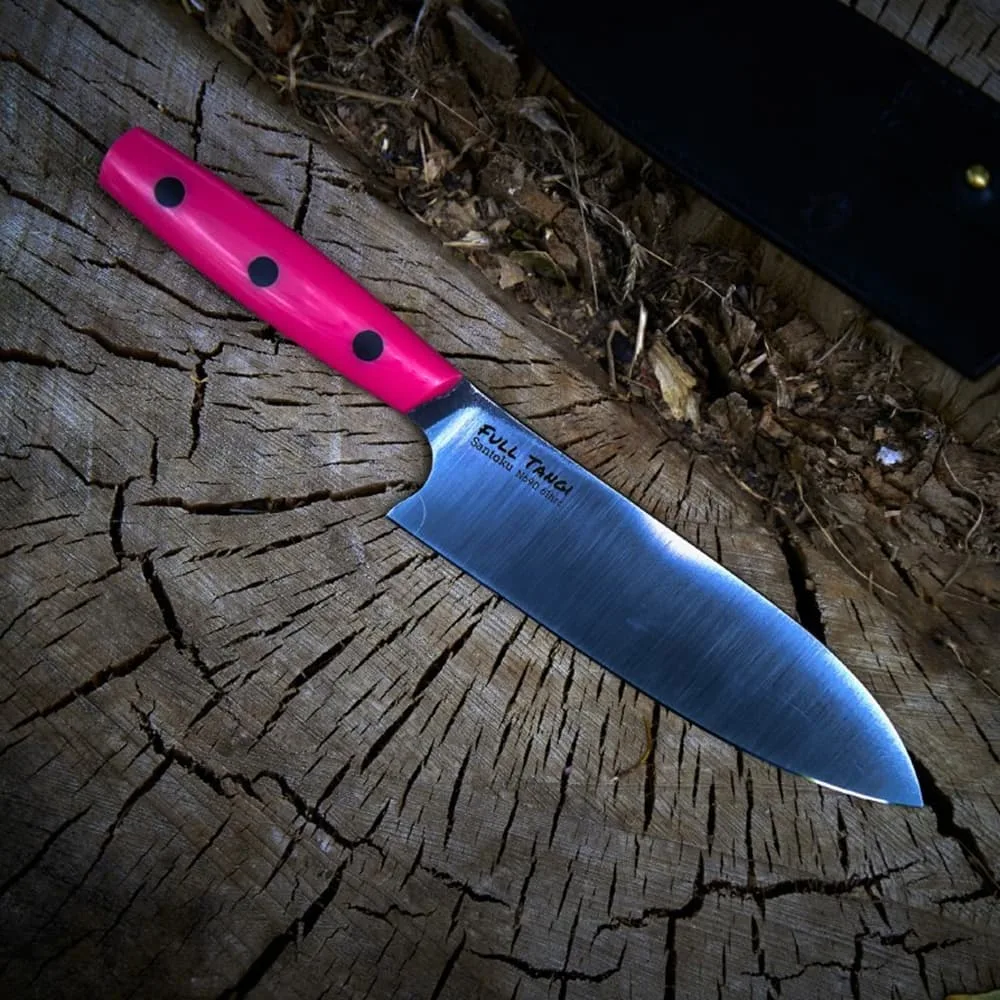
I don’t carry them all at once. I choose the one that the day requires. That is what my father meant by “honest.” Not that you own everything, but that what you own answers a real question.
The Conversation With the Stone
Some nights, the house is quiet enough to hear how small you are. Those are the nights I take out a stone and a blade and repay attention with attention. I set a cup of tea on the bench because whisky makes me sentimental when I need to be precise. I pace the angle by feel, the way the wrist remembers a handshake. I watch the burr form and then vanish. I think about the thing a good maker does that no machine can, which is to leave a little mercy in the steel so that when you miss the angle by a breath, the blade does not ruin you for it.
If you listen, the stone tells you when the blade is ready. It’s a change in sound, a smallness in scrape, the hush that arrives when friction turns to agreement. I wipe the edge on a cloth and look for a reflection that is not eager but complete. Then I do the thing he taught me that makes no practical sense but all the human sense in the world: I thank it. “You will do what I ask,” I say softly, so I will hear myself promise to be worthy of what I own.
Passing It On
My son is not twelve yet, but he is close enough to borrow my shadow. I have caught him staring at the bench the way a boy stares at a river, wondering if it will carry him away or let him keep his feet. He has his mother’s curiosity and my impatience, which is either a good blend or a fire waiting to choose what it will burn. I clean a small blade built by a man whose shop sits between wheat and weather and call the boy over.
“This is not a toy,” I say, and I hear a ghost behind the words, and it doesn’t make me sad, which surprises me. “It will remember how you use it. So will I.”
We talk about steel the way you talk about the weather before a trip. He likes names because names are how a boy makes friends with a thing. I tell him that numbers matter, but not before manners. That a knife is a question you must answer each time you take it out: Are you careful? Are you ready? Are you here?
We go outside and teach the stick to be something it was not – kindling, a peg, a small tent of curl and warmth. His first featherstick looks like a dog that asked to be forgiven, but he smiles anyway because smoke agrees with boys. I show him the spine striking the rod and the edge sparing itself. He laughs when the flame takes like a shy animal finding courage. The blade is too big for his hand right now. That’s all right. Some things are supposed to be grown into.
On the way back in, he asks if the knife will be his. “One day,” I say. “Not because you want it, but because you will be ready to keep it.” He nods like he understands. Maybe he does. Maybe he just likes the idea of someday.
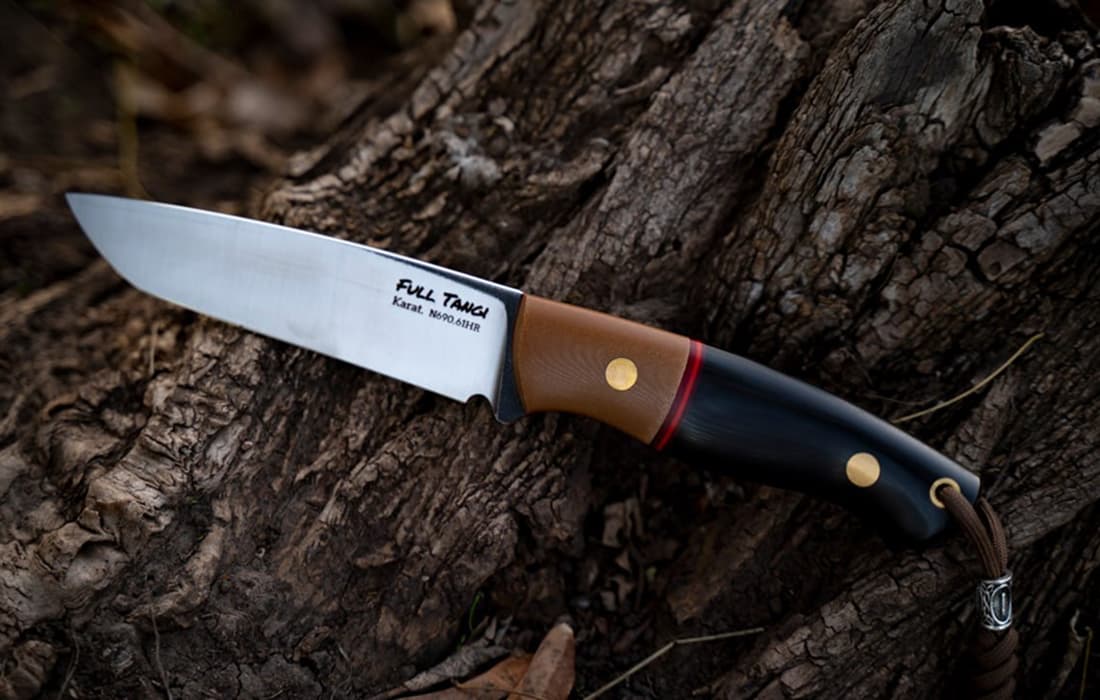
Why Handmade Still Matters
We live in a noisy world that wants to sell you noise. It will promise that a thing built by a thousand machines and a bored committee can love you back if you only sign here. But a handmade fixed blade knife is the opposite of that bargain. A person stands at a bench and makes a series of decisions that become a series of responsibilities. He chooses steel and heat, shape and edge, handle and finish, sheath and hardware, not to impress you but to protect you. He puts his name on it not because you will remember him, but because he must remember himself, and a handmade fixed blade knife carries the handprint of its maker.
I have met the men and women whose work we carry at Knifia. Their hands are older than their faces. Their faces are younger than their eyes. They have made beautiful things because their lives demanded it, and they have made durable things because beauty without durability is only decoration. When they talk about knives, they talk about people: the soldier whose hand was cold, the hunter whose morning was wet, the cook whose patience was thin. They do not use the word “customer” like a shield. They say “the next owner,” as if trust is a chain you are allowed to hold for a while.
That is why I still prefer a blade built by a person to one stamped by a story a marketer invents. The person is the story. The blade knows it. So will you.
The Quiet After
There are days when I miss the old man with a violence that startles me. It happens most when a task goes well and I look up to see if he noticed. He does not, because that is how absence works. But the blade in my hand behaves like company. It has opinions. It offers help. It declines panic. That is all most of us ever wanted from our fathers, if we are honest: a steady presence that does not clap for us but stays.
At night, I put the knife away and feel the small weight gone from my belt the way you feel a ring vanish from a finger. I turn off the light in the workshop, and the room returns to dusk. Outside, the world ends and begins, which is the job of night. The bench holds its breath. The stones remember angles. The cloth remembers oil. The edge sleeps in its sheath like a sentence that knows its verb.
In the hallway, my son’s door is half shut. He is asleep, face turned toward what he dreams. On his little desk, a drawing of a knife that looks exactly like a knife a boy would draw—too long, too bright, edged on both sides as if he expects difficulty. I touch the paper and think of his hands at the bench, not yet steady, soon enough steady. I think of what I will say to him when he asks for a blade that is his and not mine.
I will say what was said to me: “A tool, not a toy. It remembers you.”
And I will say one thing more, because it took me too long to learn it: “You don’t own it. You care for it. One day, you will pass it on. Make sure it has something worth carrying.”
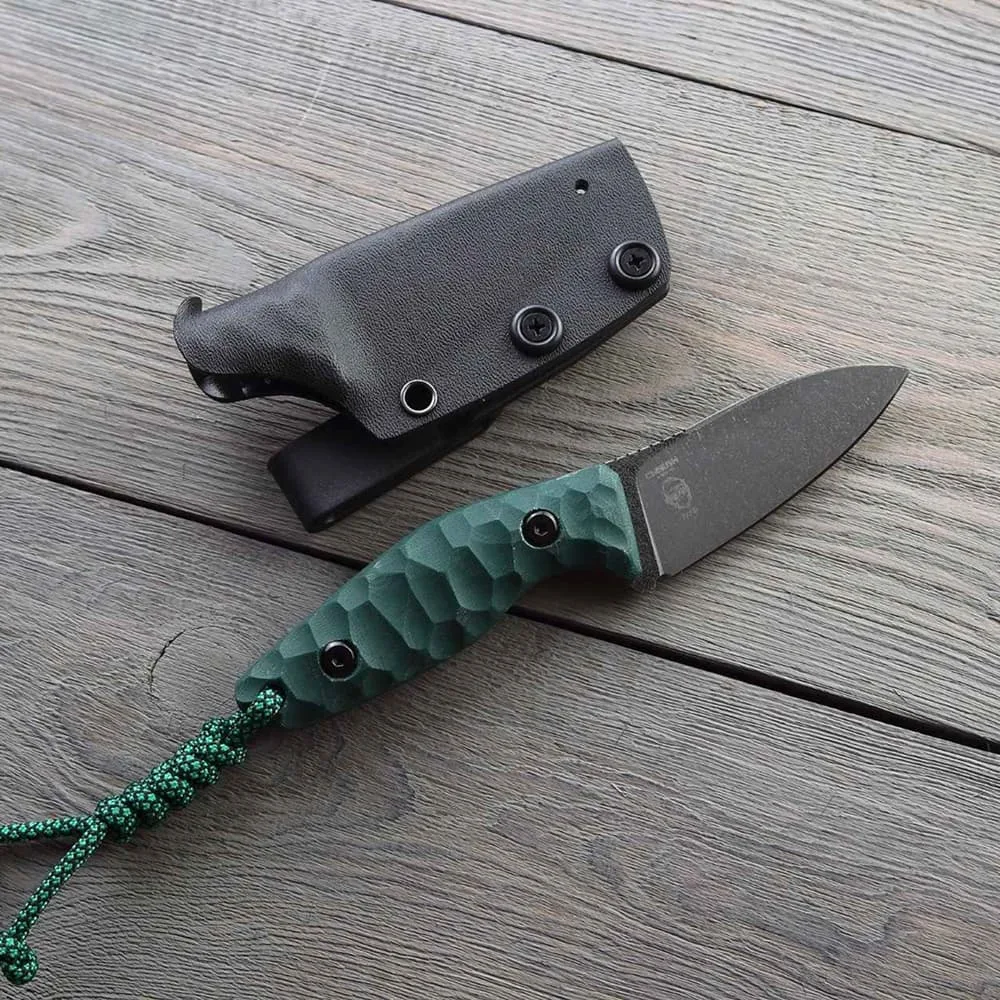
If You’re Choosing Yours
If you came here wondering what to buy, I’ll give you the short truth my father preferred, gilded with the long truth he raised me to respect.
- Lengths that work: 4–5 inches of blade for most lives. Long enough to bite. Short enough to steer.
- Thickness that forgives: 0.14–0.18 inch (3.5–4.5 mm). Thin slices, thick spines, no apologies.
- Hardness that endures: around 58–60 HRC for the middle path; harder if you’re gentle, softer if you’re not.
- Grinds that tell the truth: Scandi for wood and teaching, convex for punishment and grace, full flat for versatility.
- Handles that hold on: Micarta and G10 when rain and rope conspire; stabilized wood when you want warmth that will not swell.
- Tang that stays: full tang, always, if you expect to split, pry, and still carve.
- Sheaths that serve: Kydex for weather and duty; leather for silence and tradition.
- Makers who matter: pick the hand, not the hype. If you want examples, start with Full Tangi for blades that feel inevitable, Chinush for knives that are playful and precise, and Skull Crusher when your day needs a sentence with an exclamation point.
And then – this is the part nobody prints on a box-keep the agreements you make with the blade. Clean it, oil it, sharpen it. Use it for work, not performance. Tell it thank you when it earns it. Teach someone else what you were taught. That is how a tool becomes an heirloom. That is how steel learns to carry a life.
When I put the old knife away at night, I do not feel that something has ended. I feel that it is waiting. There are still knots to refuse and onions to surrender, and rope that thinks it is the stronger one. Some trips will ask to be mended, fences that will ask to be believed, small fires that will ask to be born. A good blade doesn’t make you brave. It makes being brave simpler.

And when my son is ready – when his hands know how to ask, not how to demand – I will wrap the knife in the cloth that smells like oil and cedar, and I will put its weight into his palm. I will watch his heartbeat change. And I will stand there quietly while two old friends are introduced, and a third watches with his hands in his pockets, just to keep them from trembling.
Because in the end, the edge between generations is not sharp. It is patient. It is carried. It is handed over.
Choose the honest thing.
Choose the thing that will remember you kindly.
Choose a handmade fixed blade knife you’ll be proud to pass on.
